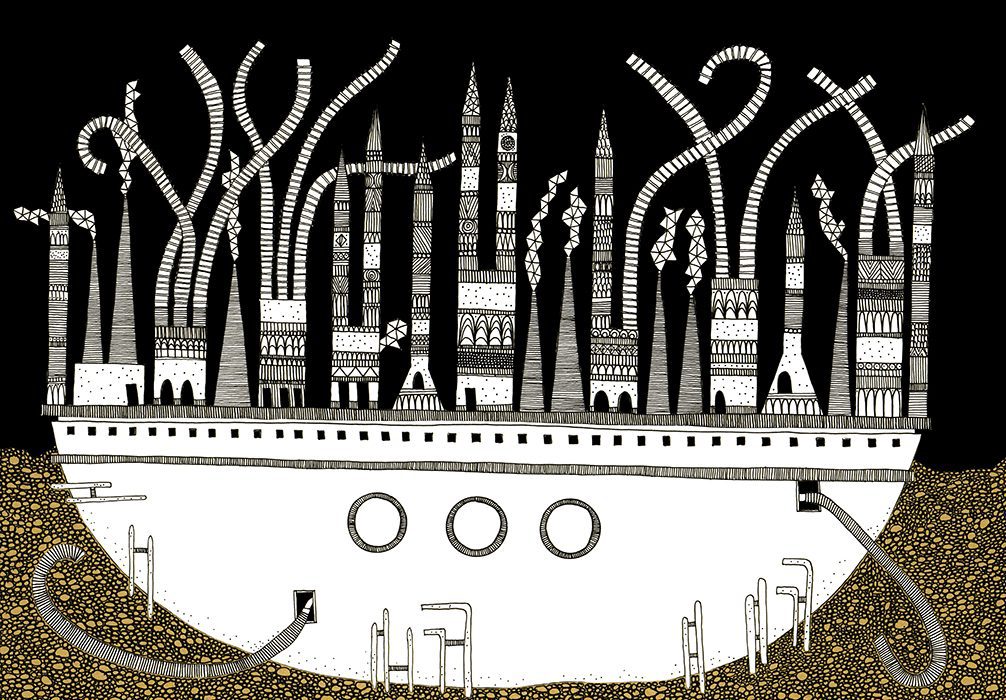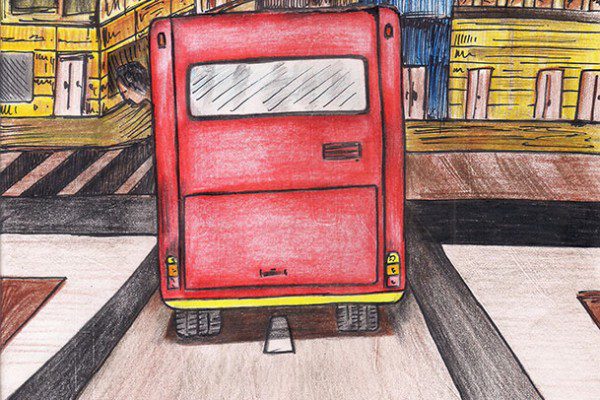Lima-based Karina Puente, who describes herself as an urbanist by day and an artist by night, talks to Pratiti Ganatra about her ambitious project of trying to illustrate the cities in Italo Calvino’s ‘Invisible Cities’.
How did you come across Italo Calvino’s Invisible Cities and decide that you wanted to work on illustrating the cities written in the book? Tell us a little about this project in detail.
It’s a long story, but I’ll do my best to keep it short. I read Italo Calvino’s book when I was in college, studying architecture. I really did not understand it much and did not connect with what he was saying at that time. I just knew it was a book architects talked passionately about.
I was a good student, but I always hoped I could draw better than I did. I remember that other students could draw incredibly well. This was when we still had to draw many of our projects by hand, and I always thought I was not good enough in that way or that the way I drew was not suitable for the academy. I’ve always had this kind of childish way of representing things. Finally, I graduated and started working at an architecture firm, became a professor of design. I studied for a Masters in Real Estate, which I thought was the best thing at that time. No funny business.
Nine years later, in 2013, I made a huge change. I had been working as an architect a long time, a difficult task in my country, and I was tired of designing residential buildings between dividing walls for real estate companies and beach houses. I wanted to have a say in things rather than just do what I could. Therefore, I quit the private sector and joined the public sector. I wanted to be a part of the game changers. That’s when I learned that the City Hall of Lima was organising a team of architects and urbanists to work on the urban plan for our city towards 2035, and I jumped at the opportunity. It was an amazing but overwhelming experience. We had to work very hard and fast because elections where near and we didn’t have much time. In addition to this new job, my husband had just left to study an MBA abroad for a period of two years. Even though it was a very important step for us, it was also very sad, since we had recently become parents and I had become unexpectedly a single mother of a two-year-old!
One day I just sat down and drew a very tiny city that I named “the city beneath the city”. It showed a slum on top of a hill (with all the problems that slums have) and a city beneath it with public spaces, greenery, water, cultural activities, art and colour! An evident contrast in the quality of life.
All of these events, all together, just made me look for something to occupy my mind and not think too much. I actually believe that when you don’t think too hard on something, things come out naturally. Therefore, I started to play, draw, paint and do all sorts of artistic tasks just for fun and entertain my son at home. We would make action painting with large papers on the floor. We would try many different materials, build entire cities in cardboard and cover the walls with drawings. We would also visit museums and art galleries all the time. I think that in a way, all this sparked my imagination again into that direction.
And then one day I just sat down and drew a very tiny city that I named “the city beneath the city”. It showed a slum on top of a hill (with all the problems that slums have) and a city beneath it with public spaces, greenery, water, cultural activities, art and colour! An evident contrast in the quality of life. I had seen so much when we were analysing our city’s problems that I had gotten overwhelmed. I felt the need to draw something. I liked that drawing very much and just then remembered Calvino’s book. That’s what jump-started the project. I decided to illustrate his book in a way for my son to understand and as part of the fun things we would do together. I enjoyed it. At first, I had to Google his book because I could not find it anywhere here in Lima, until a friend who saw the drawings I had made gave me his. So, I am now working with a book that had a previous owner.
I now consider myself an architect that draws. I work as an urbanist by day and as an artist by night. I illustrate up until morning sometimes. I think I’m one of those people who wanted to be an artist but became an architect instead. Even so, I would not change my career choice now.
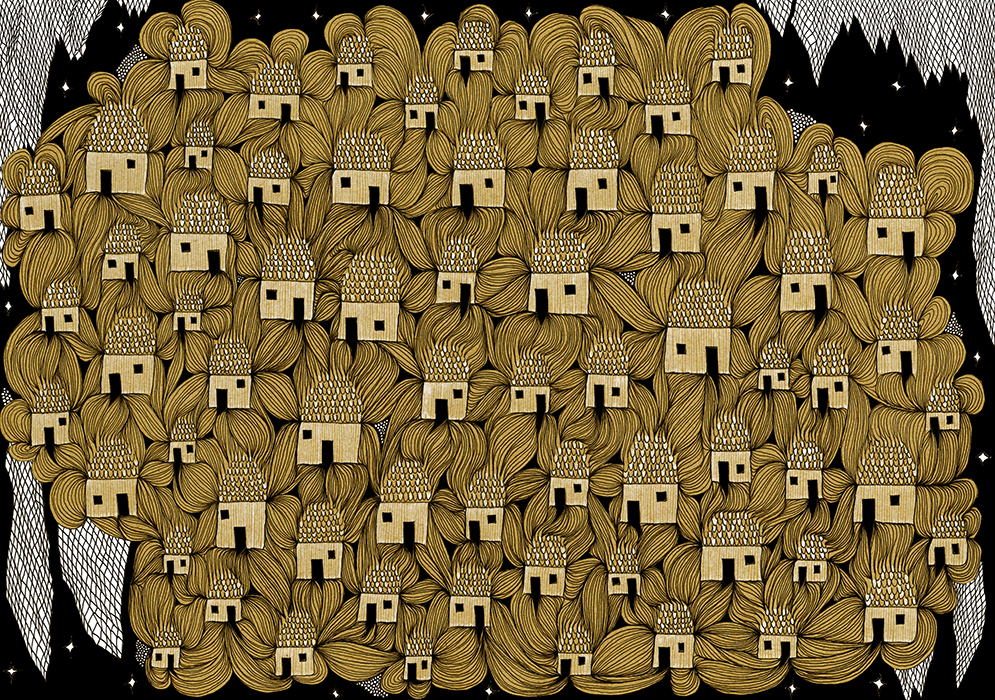
Zaira
Have urban areas/cities always been something that have fascinated you?
Yes! I am the daughter of a diplomat and so I have lived in many different cities through my life. When I was only one year old, we moved to Helsinki, five years later to Wellington, and since then I have lived in Lima on and off, in between Guatemala City and Caracas. Additionally, my father also used to travel a lot and every time he did, he would bring me a book of the city or country he had visited. He had been to many cities, such as Beijing, Singapore, Washington, etc. He always told me about his experiences in every city. In addition, my mother always tells me the story about the time they went to New York City for the first time and I was still in her belly jumping around. I just love cities; I read about them, teach about them and draw them.
There is something absolutely amazing and fascinating about cities, even more so about metropolises and megalopolises. I am interested in all of them, tiny, huge, historic, creative, problematic or cosmopolitan; every single one has something worth admiring. One of the things that deeply interests me is the powerful exchange of knowledge that happens in cities and the multiple and diverse sociocultural interchange we witness. The more hectic a city is, the more interesting for me. There is something magical about people living close together.
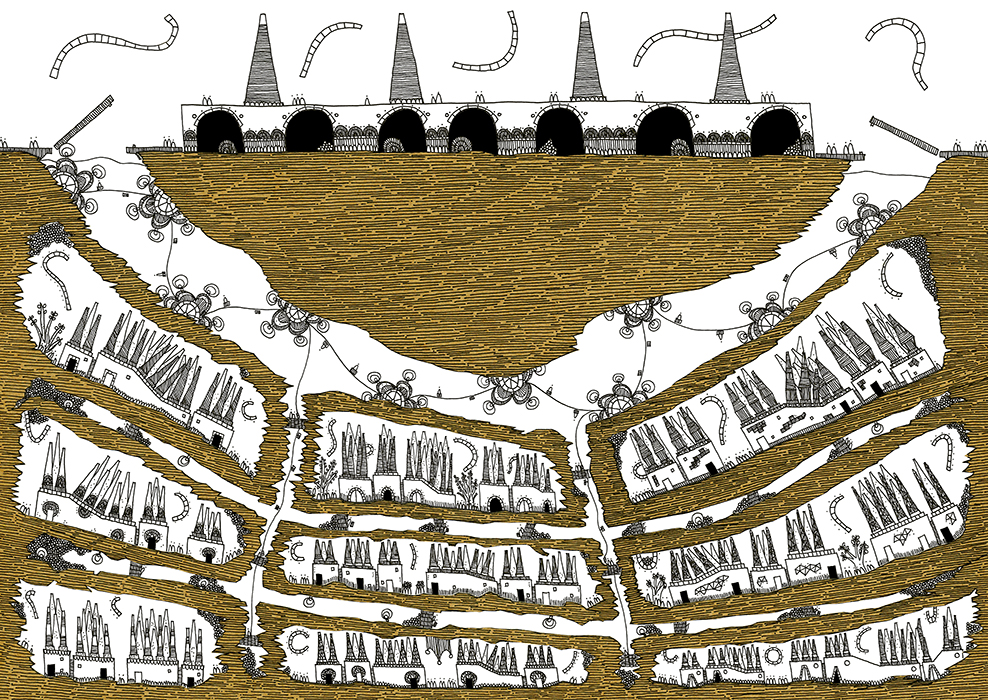
Dorotea
Calvino says in the book, “With cities, it is as with dreams: everything imaginable can be dreamed, but even the most unexpected dream is a rebus that conceals a desire or, its reverse, a fear. Cities, like dreams, are made of desires and fears, even if the thread of their discourse is secret, their rules are absurd, their perspectives deceitful, and everything conceals something else.” So how do you imagine these dreams and fears while you are trying to illustrate them?
Dreams, fears and desire are very powerful concepts! I try to leave their interpretation open for the viewer to read and feel when I illustrate them. In each one, these concepts are represented (if present) with different strategies.
There is something absolutely amazing and fascinating about cities, even more so about metropolises and megalopolises. I am interested in all of them, tiny, huge, historic, creative, problematic or cosmopolitan; every single one has something worth admiring.
I could tell you about how I decided to make Anastasia city, which is part of the chapter ‘Cities and Desire’. Anastasia is a city of deceit. Calvino talks about how you think you are happy living inside her but you really aren’t, about that duality. So, I represented a city on top of another city. The city on top is a happy city, with kites and elevated streets, while down below there is a mining city, with no light and where you have to work all day long and are trapped. In this case, dreams and desires are represented on top and fear is represented underground.
The city appears to you as a whole where no desire is lost and of which you are a part, and since it enjoys everything you do not enjoy, you can do nothing but inhabit this desire and be content. Such is the power, sometimes called malignant, sometimes benign, that Anastasia, the treacherous city, possesses; if for eight hours a day you work as a cutter of agate, onyx, chrysoprase, your labor which gives form to desire takes from desire its form, and you believe you are enjoying Anastasia wholly when you are only its slave.
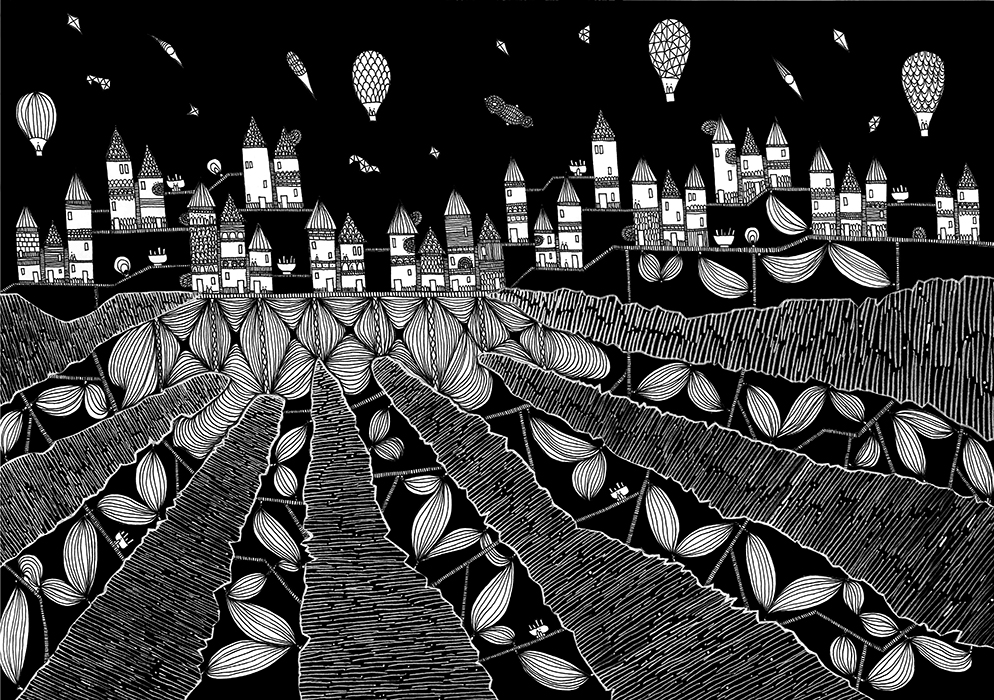
Anastasia
In Wanderlust: A History Of Walking, Rebecca Solnit says that “[a] city always contains more than any inhabitant can know, and a great city always makes the unknown and the possible spurs to the imagination.” So when you are reading Calvino, do you get this feeling that the city you are about to illustrate has these elements of unknown? I mean, are there bits in the illustration, which are purely your imagination and not in the text?
All the time! I think that illustrating Italo Calvino’s book is an excuse to draw about what is in my own head. The relationship between the imaginations of the doer in contrast with the words of the author is a very complex one and never repeats itself. When reading his words my mind just wanders off to imagine different forms and details that come from my own experiences. Giving shape to what only existed in his mind when writing (shapes that we will never know about) is what motivates me.
I like reading beyond the words so the viewer can read beyond the illustration. It has a bit of mystery to it all. Although some people don’t like the fact that I give shape to his “invisible cities”, mainly because I contaminate them with my own views, it’s a personal project, so I don’t read into that so much.
Dreams, fears and desire are very powerful concepts! I try to leave their interpretation open for the viewer to read and feel when I illustrate them. In each one, these concepts are represented (if present) with different strategies.
When I read the description of each of the cities the ideas don’t come so fast. I have to digest the content first. I read it several times and just let the words wander in my mind for a few days or how long it takes for me to have the urge to sit down and sketch. Sometimes it can be a week, sometimes more. A subconscious process goes on without me controlling it. The best ones have come out that way.
With Isidora for example, one day I posted the drawing I made of her on the web and a friend of mine said, “Hey, I see the plaza!” Calvino talks about a woman sitting in a square. I had not drawn a square, but the structure of the city had left the borders of the paper in black and the centre in white. This was for him the representation of a square. I was delighted to see the effects of the subconscious process. Finally, the square was there, it appeared whether I drew it intentionally or not.
I had not noticed but I also tend to draw something outside of the original text on purpose depending on what is happening in the moment I’m working. After I read this question and thought about it a little I realised it. For example, in Zirma city it’s snowing because I made her near Christmas day. Maurilia has a full moon right smack in the centre because that day there was a beautiful full moon in Lima and I could see her through the fog! Even so, I love that the illustrations I do suggest different things to each viewer, and the interpretations change as the viewer changes.
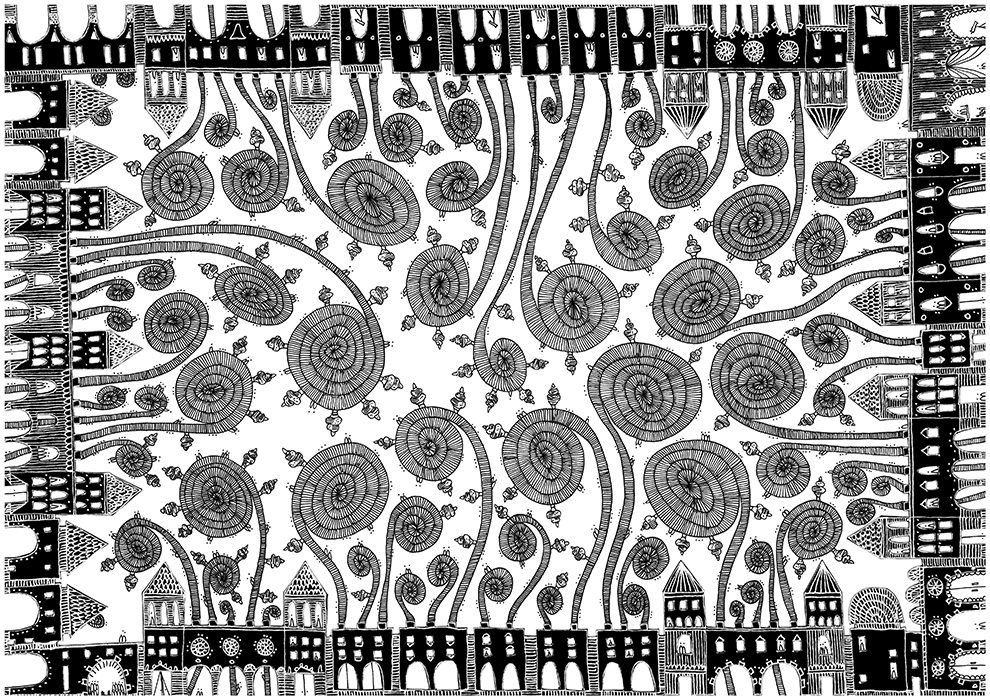
Isidora
Tell us a little about the different materials and techniques you use for these pieces?
I use mixed media and collage techniques, but mainly make ink drawings on paper that I later cut out with my blade and glue to other papers (in layers). In addition, I use acrylic paint markers. The technique I think comes from making architecture models (which I have always loved to do). I cannot draw on one paper in only one layer; I always start with a cutout and that structures the entire piece and then I draw around it.
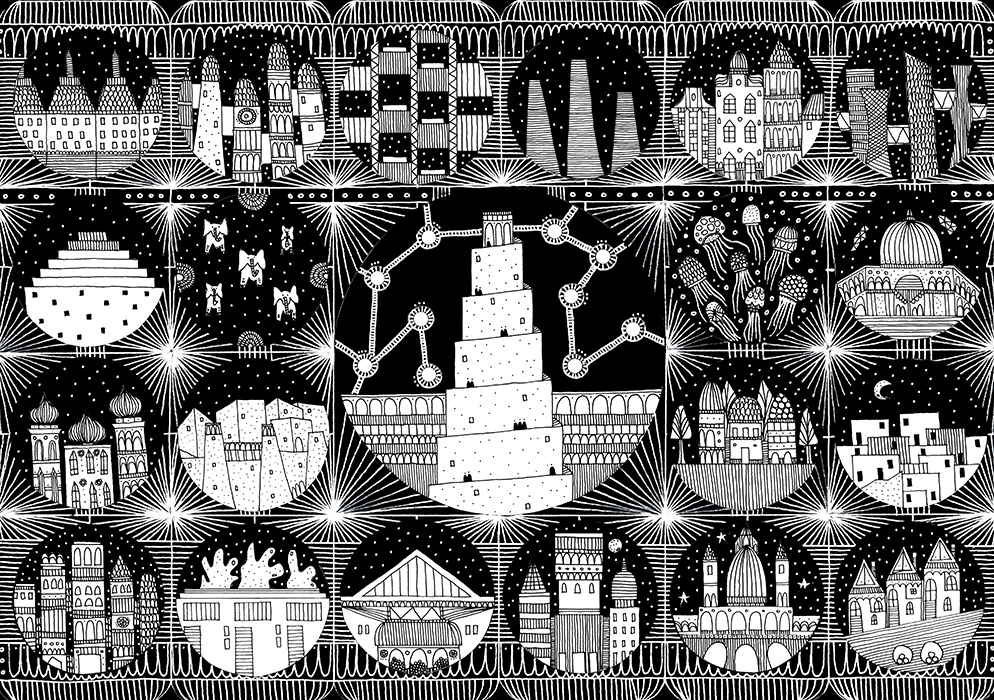
Fedora
PD Smith has written that “ideal cities are very much the product of their own ages. Designed as complete urban statements, they bear the unmistakable imprint of their own culture and worldview in every street and building. And yet to be successful a city has to be open to continuous development, free to evolve and grow with the demands of new times. Like science fiction accounts of the future, ideal cities quickly become outmoded.” Do you believe in this idea of an ideal city? And if so, what would it look it, if you were to illustrate it/visualise it?
I do believe that cities should be open to continuous development and reinvent themselves throughout their lifetime, but at the same time stay true to their own essence. More so, if they are cities with cultural or historical attributes. Although, I am not in favour of keeping cities museum-like. That actually kills their spirit and leaves them obsolete. A city is definitely not a museum.
Although some people don’t like the fact that I give shape to his “invisible cities”, mainly because I contaminate them with my own views, it’s a personal project, so I don’t read into that so much.
I think there are several cities that reinvented themselves like New York or Bilbao but kept their spirit alive. Others have not had that same luck, like Detroit to name one.
What would an ideal city look like to me?
I think my ideal city would be full of public spaces, museums, stores in front of big pedestrian walkways, tall buildings that contrast with low ones connected by cableways and trams; there would be people flying over in balloons and paragliding; land art everywhere, cafés filled with people, antique stores, small markets exploding with merchandise. The city would have parks for children and old people built around almost every corner; lots of places to sit and trees to give shadow to everyone. No gated communities. There would be fewer cars and more people walking. Also, there would be Archigram-type structures from where to see the landscape and possibly urban spaces alongside a river that would turn their lights on at nights and just glow.
I think my ideal city would be full of public spaces, museums, stores in front of big pedestrian walkways, tall buildings that contrast with low ones connected by cableways and trams; there would be people flying over in balloons and paragliding; land art everywhere, cafés filled with people, antique stores, small markets exploding with merchandise.
I think Calvino details a few of them in his book. He talks about happy cities and sad cities. I think Maurilia is one of the nostalgic cities, maybe a sad one—the antithesis of an ideal city. He describes her as a provincial city that did not survive change. Here is an extract:
Beware of saying to them that sometimes different cities follow one another on the same site and under the same name, born and dying without knowing one another, without communication among themselves. At time even the names of the inhabitants remain the same, and their voices’ accent, and also the features of the faces; but the gods who live beneath names and above places have gone off without a word and outsiders have settled in their place. It is pointless to ask whether the new ones are better or worse than the old, since there is no connection between them, just as the old post cards do not depict Maurilia as it was, but a different city which, by chance, was called Maurilia, like this one.
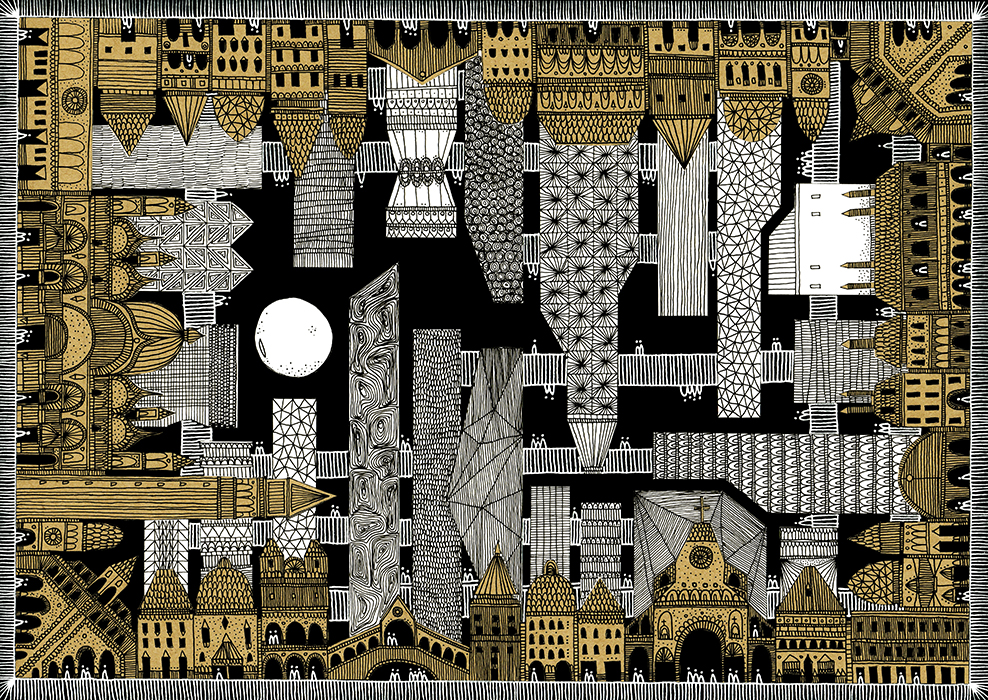
Maurilia
How important is it to be a well-travelled person to execute a project like this? Do you think travelling a lot, and actually visiting multiple cities helps in visualising what Calvino is writing about?
I think it is very important to travel. There is a limit to what you can see and feel when you look at photographs or videos. Living in cities, walking through them, discovering them with all your senses is what moves me. Visiting the main square, where it all began, the market places and of course, their public spaces. All those spaces talk to you in some way, leave impressions. What I tend to do is draw in my journals when I travel and try to register as much as I can. Maybe when I read Calvino’s cities I remember much of what I have seen.
I recently saw a video of an interview with Calvino in Paris (1974). The journalist took him out of his studio and walked around. Suddenly they stopped at a cheese store. I completely agree with what he said at that moment; he said that you could actually read a city, absorb information of that city through, for example, the stores in front of a busy street. If he would have to write a book on cheese, he would probably go to that store and learn from it like if it were an encyclopædia. Sadly, those kinds of stores are being replaced nowadays with generic shopping malls so that type of experiences are slowly disappearing.
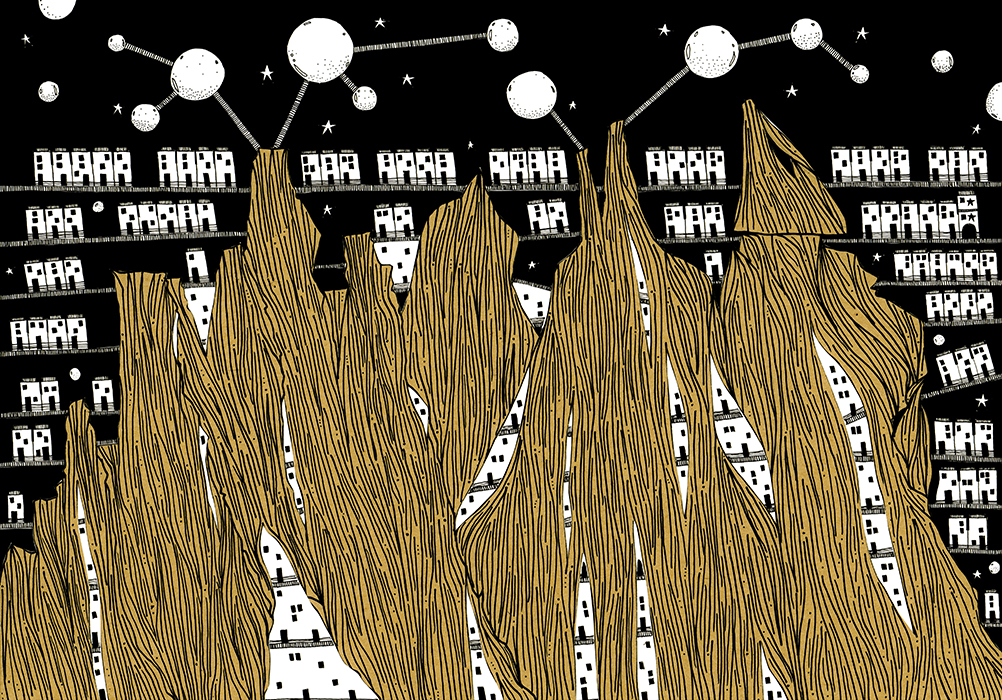
Zora
Lastly, what is your final vision for this project?
I wish to illustrate the 55 cities of the book. I started a year and a half ago and I have finished 12 of them. It is a project that I deeply care about and I know that when I finish, seeing them all together will be something very special.
Sometimes I imagine myself showing Calvino the collection of drawings I have done and visualise him practically insulting me in the face while moving his hands Italian style. Almost like saying ¡come ti permetti! (How dare you!)
I dare! I dare because it is an experiment, because it is not a job or a commission. It is a personal project, done by and for me because I love to do it and comes natural to me.
Who knows, maybe this changes my life and turns me into something I did not know I could be.
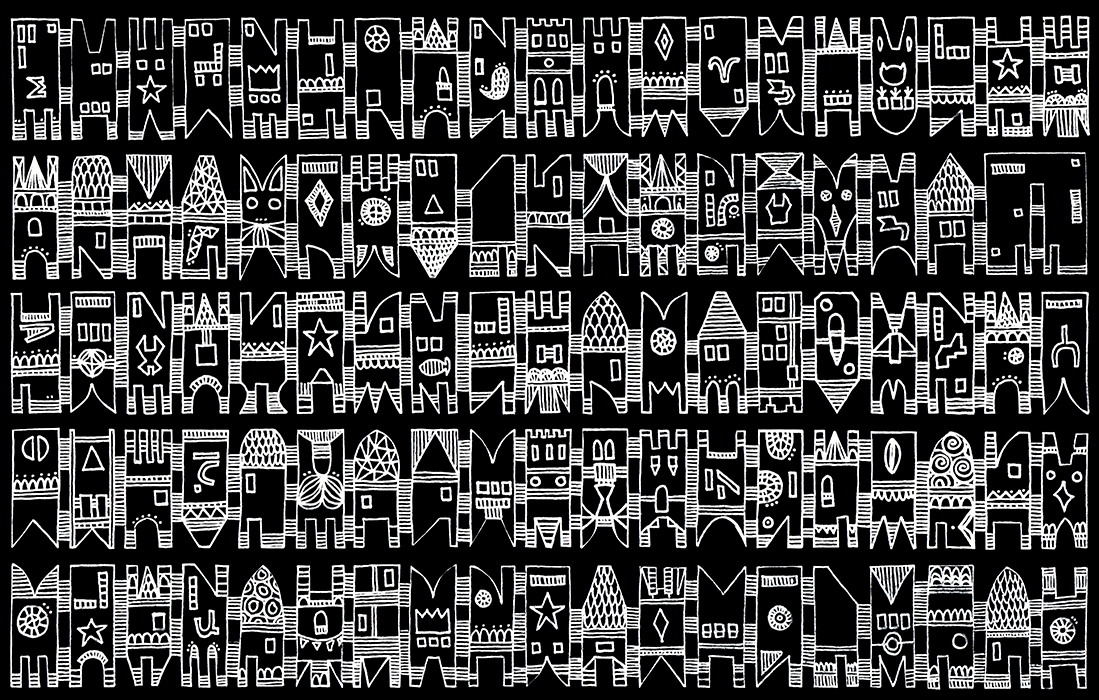
Tamara

